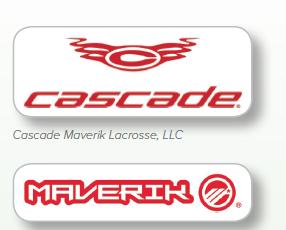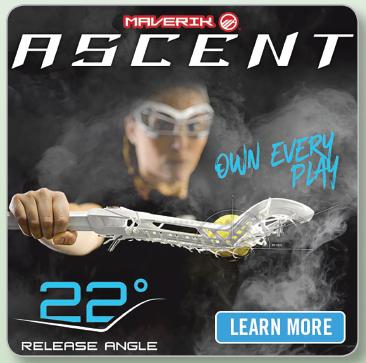Weve worked hard to ensure that we surround ourselves with really strong, talented, curious people, and our
Question:
“We’ve worked hard to ensure that we surround ourselves with really strong, talented, curious people, and our salesforce exemplifies that,” says Tim Ellsworth, global business director for Cascade Maverik Lacrosse.
Ellsworth has managed many aspects of the business that have helped the company become the number one brand in lacrosse equipment. “We have a sales organization, a marketing organization, a manufacturing organization, and an R&D organization; it’s very interdisciplinary,” he explains. World-class product development, designs that are “powered by the player,”
rapid U.S. production facilities, and a passion for athlete safety are all important parts of the message the salesforce brings to market.
THE SPORTING GOODS INDUSTRY AND THE GROWTH OF LACROSSE The sporting goods industry generates about $100 billion in retail equipment sales for all sports, and is expected to grow for the next five years. Industry growth is driven by technological advancements and customization, increases in consumer discretionary income, and shifts in the popularity of different sports. Sporting goods manufacturers sell products through sporting goods retailers, department stores, mass merchandisers, and directly online.
Participation rates in many sports are changing.
Tackle football and soccer have experienced declines in youth participation. At the same time, other sports such as inline skating, skateboarding, mountain biking, snowboarding, parkour, and base jumping are becoming more popular. While basketball is the most popular team sport, baseball, ice hockey, and lacrosse have been growing. In fact, during the past two decades lacrosse has been the fastest-growing team sport among male and female players at the youth, high school, college, and professional levels. According to Ellsworth, “
Lacrosse is still a relatively small sport compared to basketball, baseball, and football, but the sport is really contagious. People are getting addicted to our sport once they engage and understand a little bit about it!”
THE SALES MANAGEMENT PROCESS AT CASCADE MAVERIK To achieve the company objective to be “the fastest supplier of high-performance lacrosse gear,” Cascade Maverik utilizes a rigorous sales management process.
The process addresses several key tasks including organizing the salesforce. According to Debbie Errante, sales manager at Cascade Maverik, the “salesforce is broken out by geographic territories throughout the

U.S., and key accounts, typically based in highly populated areas, are also supported by the salesforce.” Other sales management tasks include recruiting and selecting new salespeople, training sales representatives, and designing a compensation program.
The recruitment and selection process requires finding people who match the culture and requirements at Cascade Maverik. Errante explains: “We have a lot of people on the road who are not based out of our corporate offices and therefore they need to be self-motivated, and a good teammate. Most of our employees are actually coming out of playing some type of sport so they understand the team mentality.”
Other important attributes include computer skills, communication skills, and particular personality traits. “We are looking for sales representatives that are personable, that can communicate, are selfmotivated and have a positive attitude, showing a smile, coming in well-dressed, and looking like they’re prepared for the day and ready to be a go-getter,” says Errante. The application process at Cascade Maverik usually begins with an online application, then an online interview, and finally a face-to-face meeting that may include a presentation. Errante observes that it is “important that a sales representative is comfortable in front of a room.”
Salesforce training at Cascade Maverik consists of corporate office training and on-the-job training. “Our training process starts by meeting some of your key team members as well as getting some background information on your key accounts,” explains Errante.
New sales representatives also spend time learning the administrative activities that take place in the office.
The on-the-job component of the training includes participating in sales calls and presentations with senior salespeople. “Whatever it takes to make sure that they feel confident once we send them out into the marketplace to be successful at their job,” says Errante.
At Cascade Maverik, compensation is a combination of salary and commission. According to Errante, “Salary allows our employees to step into their role confidently, and commission is about motivation.” Providing an incentive for serving new customers and being completely up-to-date is particularly important as the sport grows and changes. “The growth of the sport as well as new rules, regulations, and products are something the sales team needs to take into consideration. If they can’t sell the product, then we can’t be successful as a team,” says Errante.
THE SELLING PROCESS AT CASCADE MAVERIK The personal selling process at Cascade Maverik focuses on building customer relationships. Laura Edward, a territory sales representative for Cascade Maverik, explains:
“It’s extremely important to establish a relationship with the person you’re selling to. When I’m building a relationship with a coach, it’s extremely important to get to know them a little bit. I think that’s important for a long-lasting relationship rather than just one sale.” Sales representatives typically follow the steps identified in Figure 21–3 to build relationships.
The process begins with prospecting, or identifying new customers. “I spend about 25 percent of my time prospecting, finding potential leads, talking to coaches,”
says Edward. “You really have to hit the road to find the coaches that we want to sell to.” The second step is to gather information about the prospects’ needs. “I want to understand their equipment needs and how our products can align with those needs,” explains Edward. The

next steps are to arrange a meeting and make a presentation.
According to Edward, “Once I’ve set up a time and place to meet with a coach, it’s time to present our product line and the benefits that we can bring. It’s important to cater to the coaches and their schedules.” Step five is to “close” by asking for an order and obtaining a purchase commitment from the coach. Finally, sales representatives must follow up to ensure that the customer is satisfied. “Once the product is delivered you want to follow up with the coach or athletic director to see how the equipment is meeting their expectations,”
says Edward. “It’s our goal to have every coach extremely satisfied.”
Cascade Maverik sales representatives also use the selling process to maintain relationships with existing customers. Information about past purchases helps the team evaluate future needs. Cascade Maverik’s commitment to its customers and the sport is creating an exciting success story. Watch for a lacrosse game coming to your community soon!45
Questions
1. What factors are contributing to the growth of lacrosse and lacrosse equipment?
2. What are some of Cascade Maverik’s success factors?
3. How does Cascade Maverik approach sales management functions such as recruitment, training, and compensation?
4. How does Laura Edward create customer value through the personal selling process?
Step by Step Answer:






